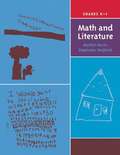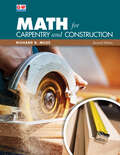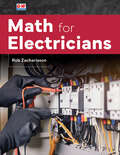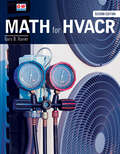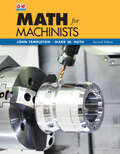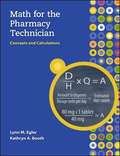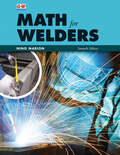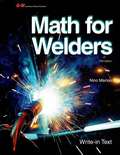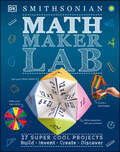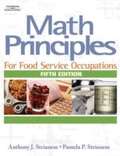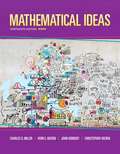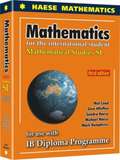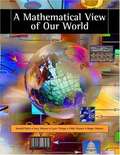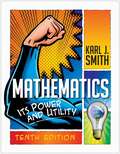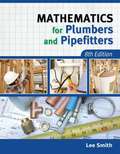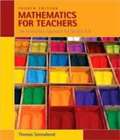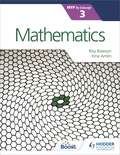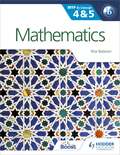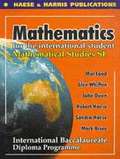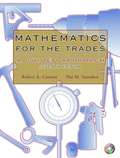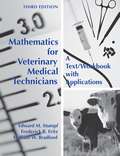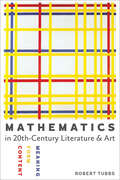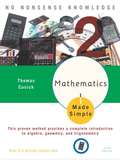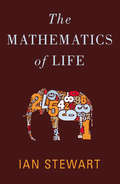- Table View
- List View
Math and Literature (Grades K-1)
by Marilyn Burns Stephanie SheffieldFrom Quack and Count to Harry Potter, the imaginative ideas in children's books come to life in math lessons through this unique series. Each resource provides more than 20 classroom-tested lessons that engage children in mathematical problem solving and reasoning. Each lesson features an overview, materials required, and a vignette of how the lesson actually unfolded in a classroom. This book includes a reference chart indicating the mathematical concept each lesson covers, such as number, geometry, patterns, algebra, measurement, data analysis, or probability. Topics include counting, sorting, addition, subtraction, money, measurement, and patterns.
Math for Carpentry and Construction
by Richard B. MilesMath for Carpentry and Construction is designed to help carpentry and construction students learn and apply basic math skills. The basic concept behind each math operation is explained at the opening of the unit. Next, students are given clear instruction for performing the operation. Each unit includes a variety of carpentry-and construction-related practice problems to reinforce what the students have learned. The practice problems are identical to the types of problems the students will be required to solve in a carpentry shop or on a construction site. In addition to teaching basic math concepts, the problems give students a preview of the types of challenges they will face in a work environment. This helps the students develop solid troubleshooting skills that will serve them throughout their careers as carpenters and builders.
Math for Electricians
by Rob ZachariasonMath for Electricians provides a review of basic math within a framework of electrical applications, helping students gain confidence and achieve success in math-based electrical tasks. The author has taken a practical approach to cover the basic math concepts used by electricians and other electrical industry professions, beginning with a refresh of basic mathematical operations and continuing with whole numbers, common fractions, decimal fractions, percentages, ratios, proportions, systems of measurement, electrical calculations, and algebraic, geometric, and trigonometric functions. Each mathematical concept relates to an industry application with real-world examples and practice problems. Answers to odd-numbered practice problems are listed in the back of the text.
Math for HVACR
by Gary B. XavierMath for HVACR provides a review of basic math within a framework of HVACR applications, helping students gain confidence and achieve success in math-based HVACR tasks. Serving as an excellent supplement in introductory HVACR and other mechanical trades courses, the text covers whole numbers, common fractions, decimal fractions, percentages, systems of measurement, electrical calculations, and algebraic, geometric, and trigonometric functions. The author's deep industry experience as an HVACR trainer is reflected in real-world examples, illustrations, and abundant exercises in every chapter, which provide relevance for aspiring technicians. Answers to odd-numbered practice problems are listed in the back of the text.
Math for Machinists
by John Templeton Mark W. HuthThe intent of Math for Machinists is to provide students with a review of basic math operations (whole numbers, fractions, decimals, percentages), measurements, and additional math topics that are directly applicable to machining and manufacturing, such as the precision measurements, angles, area, volume, and gear calculations. Creative problems and pertinent exercises help students develop their math skills as well as their knowledge of the trade. Answers to odd-numbered practice problems are listed in the back of the text.
Math for the Pharmacy Technician: Concepts and Calculations
by Lynn M. Egler Kathryn A. BoothRecognizing the enormous need for well-trained pharmacy technicians as well as the serious need to decrease medication errors, we have developed Math for Pharmacy Technicians: Concepts and Calculations. This textbook is organized from simple to complex and walks the student through the necessary information to pass the math portion of the Pharmacy Technician Certification Board (PTCB) exam. More important, we have created pharmacy technician-specific information that is nonthreatening and will help the student learn to safely practice as a pharmacy technician. This text is organized into 11 chapters, along with a pretest and a comprehensive evaluation, or post test.
Math for Welders
by Nino MarionMath for Welders was developed specifically for welding students at any level, providing a real-world approach to learning math as it applies to welding. The text begins with a basic review of math, and then progresses to more challenging math concepts. The text features hundreds of welding-related and basic math problems to provide real-world experience and prepare students for the same scenarios they will encounter on the job. This new edition includes a second color in the design of the text to help clarify formulas and math examples and increase visual interest.
Math for Welders
by Nino MarionMath for Welders is a combination text and workbook designed to help welding students learn and apply basic math skills. The basic concept behind each math operation is explained at the opening of the unit. Next, students are given clear instruction for performing the operation. Each unit includes a variety of welding related practice problems to reinforce what the students have learned. The practice problems are identical to the types of problems the students will be required to solve in a welding shop. In addition to teaching basic math concepts, the problems give students a preview of the types of challenges they will face in a work environment. This helps the students develop solid troubleshooting skills that will serve them throughout their careers as welders.
Math in Society Edition 2.2
by David LippmanMath in Society is a survey of contemporary mathematical topics, appropriate for a college-level topics course for liberal arts major, or as a general quantitative reasoning course.
Math Maker Lab: 27 Super Cool Projects (DK Activity Lab)
by DKA fun and engaging STEM activity book for kids that combines creativity and calculations - perfect for budding mathematicians!This is the perfect math exercise book for children interested in the STEM field. Choose between 27 creative projects and experiments that will turn your child into a math whizz! It's the perfect book for curious minds interested in taking the mystery out of math. Explore the exciting world of numbers and math problem-solving! In the pages of this math book for kids you&’ll discover: • 27 hands-on creative projects to engage reluctant mathematicians between the ages of 9-12 • Easy-to-follow step-by-step instructions will show you how to make each project • All materials used can be easily found around your home with no specialist equipment needed • Every project includes an explanation of how math is involved in creating the project or the results of the experiment • Real-world math projects show that math isn&’t just abstract - it has an impact in the real world too! Produced in conjunction with the Smithsonian Institution, SI Math Maker Lab is designed to appeal to math geeks and those that prefer practical projects. To complete these engaging projects, kids don&’t need to be math geniuses or even know how to use a calculator. Each task comes with easy-to-follow instructions, photographs, and illustrations to help whip up super cool mathematics creations!SI Math Maker Lab features interesting activities that cover many aspects of the subject including measurement, geometry, and trigonometry. Kids will combine art and math by learning to draw impossible objects - creating beautiful patterns to make things like a timetable dreamcatcher or perfect the ratio for making refreshing fruit drinks. Each project has an explanatory box that demonstrates how math is applied to the activity to demystify and make math fun!
Math Principles for Food Service Occupations (Fifth Edition)
by Anthony J. Strianese Pamela P. StrianeseMath Principles for Food Service Occupations teaches students that the understanding and application of mathematics is critical for all food service jobs, from entry level to executive chef or food service manager. All the mathematical problems and concepts presented are explained in a simplified, logical, step by step manner. Now out in the 5th edition, this text is unique because it follows a logical step-by-step process to illustrate and demonstrate the importance of understanding and using math concepts to effectively make money in this demanding business. Part 1 trains the student to use the calculator, while Part 2 reviews basic math fundamentals. Subsequent parts address math essentials in food preparation and math essentials in food service record keeping while the last part of the book concentrates on managerial math. Learning objectives and key words have also been expanded and added at the beginning of each chapter to identify key information, and case studies have been added to help students understand why knowledge of math can solve problems in the food service industry. The content meets the required knowledge and competencies for business and math skills as required by the American Culinary Federation.
Mathematical Ideas (Thirteenth Edition)
by Charles D. Miller Vern E. Heeren John E. Hornsby Christopher HeerenMathematical Ideas 13/e, captures the interest of non-majors who take the Liberal Arts Math course by showing how mathematics plays an important role in everyday life. With a fresh, new focus on math in the workplace, this program shows students how math will play an important role in their future, while encouraging them to understand and embrace the mathematical concepts.
Mathematical Studies
by Mal Coad Glen Whiffen Sandra Haese Michael Haese Mark HumphriesMathematics for the International Student: Mathematical Studies SL has been written to embrace the syllabus for the two-year Mathematical Studies SL Course, to be first examined in 2014.
A Mathematical View of Our World
by Harold Parks Gary Musser Lynn Trimpe Roger Maurer Vikki MaurerHighlighting the connections and patterns of mathematics in everyday life, this textbook explains the mathematics of choice, management applications, basic statistics and probability, and how growth and decay relate to finance. Topics include voting systems, project scheduling, picturing data, survey sampling methods, and Malthusian population growth.
Mathematics: Its Power and Utility Tenth Edition
by Karl J. SmithIN THIS BOOK, we look at the power of mathematics, not the drudgery of number crunching. We look back through history and see how the power of mathematics has revolutionized the world. We also take an in-depth look at the utility of mathematics--how it is useful to you now--rather than telling you that it might be useful someday. The main theme throughout the book is problem solving.
Mathematics for Plumbers and Pipefitters
by Lee SmithNow in its 8th edition, MATHEMATICS FOR PLUMBERS AND PIPEFITTERS delivers the essential math skills necessary in the plumbing and pipefitting professions. Starting with a thorough math review to ensure a solid foundation, the book progresses into specific on-the-job applications, such as pipe length calculations, sheet metal work, and the builder's level. Broad-based subjects like physics, volume, pressures, and capacities round out your knowledge, while a new chapter on the business of plumbing invites you to consider an exciting entrepreneurial venture. Written by a Master Plumber and experienced vocational educator, MATHEMATICS FOR PLUMBERS AND PIPEFITTERS, 8th Edition includes a multitude of real-world examples, reference tables, and formulas to help you build a rewarding career in the plumbing and pipefitting trade.
Mathematics for Teachers: An Interactive Approach for Grade K-8
by Thomas SonnabendMathematics for Teachers: An Interactive Approach for Grades K-8 actively involves students in developing and explaining mathematical concepts and how the topics relate to NCTM Standards and Curriculum focal points. The text includes coverage of reasoning, sets, arithmetic, geometry, measurement, algebra, statistics, and probability. The carefully organized, interactive lesson format promotes student involvement and gradually leads the student to a deeper understanding of mathematical ideas.
Mathematics for the IB MYP 3
by Rita Bateson Irina AmlinA concept-driven and assessment-focused approach to Mathematics teaching and learning.- Approaches each chapter with statements of inquiry framed by key and related concepts, set in a global context- Supports every aspect of assessment using tasks designed by an experienced MYP educator- Differentiates and extends learning with research projects and interdisciplinary opportunities- Applies global contexts in meaningful ways to offer an MYP Mathematics programme with an internationally-minded perspective
Mathematics for the IB MYP 4 & 5: By Concept
by Rita BatesonThe only series for MYP 4 and 5 developed exclusively with the IBDrive meaningful inquiry through a unique concept-driven narrative.- Supports every aspect of assessment with opportunities that use the criteria- Gives you easy ways to differentiate and extend learning- Provides a meaningful approach by integrating the inquiry statement in a global context- Develops critical-thinking skills with activities and summative sections rooted in the ATL frameworkFeel confident that you cover the whole framework with standard and extended mathematics included - and Extended clearly signposted.This title is also available in two digital formats via Dynamic Learning. Find out more by clicking on the links at the top of the page.A proof of the first 6 Chapters of the book is now available as an eInspection copy, by clicking the eInspection copy button to the left. Rita Bateson was, until very recently, the Curriculum Manager for MYP Mathematics and Sciences at the International Baccalaureate® (IB) and continues to be involved in curriculum review. She is an experienced teacher of MYP and DP Mathematics and Sciences, and is Head of Mathematics in her current school. She has taught in many international schools in Europe as well as North America. Her interest include overcoming mathematics anxiety in pupils and STEM education. She is also the co-author of MYP by Concept 1-3 Mathematics, with Irina Amlin.
Mathematics for the International Student: Mathematical Studies Standard Level
by Mal Coad Glen Whifren John Owen Robert Haese Sandra Haese Mark BruceMathematics for the International Student: Mathematical Studies SL has been written to embrace the syllabus for the new two-year Mathematical Studies SL Course, which is one of the courses of study in the International Baccalaureate Diploma Programme.
Mathematics for the Trades: A Guided Approach (7th Edition)
by Robert A. Carman Hal M. SaundersThis book provides the practical mathematics skills needed in a wide variety of trade and technical areas, including electronics, auto mechanics, construction trades and many other occupations.
Mathematics for Veterinary Medical Technicians (Third Edition)
by Edward M. Stumpf Frederick R. Fritz William W. BradfordThe text provides a one-semester course in the basics of mathematics needed for Veterinary Technicians and Assistants.
Mathematics in Twentieth-Century Literature and Art: Content, Form, Meaning
by Robert TubbsChips away at the notion of an accidental relationship between math and art and literature.During the twentieth century, many artists and writers turned to abstract mathematical ideas to help them realize their aesthetic ambitions. Man Ray, Marcel Duchamp, and, perhaps most famously, Piet Mondrian used principles of mathematics in their work. Was it mere coincidence, or were these artists simply following their instincts, which in turn were ruled by mathematical underpinnings, such as optimal solutions for filling a space? If math exists within visual art, can it be found within literary pursuits? In short, just what is the relationship between mathematics and the creative arts?In this provocative, original exploration of mathematical ideas in art and literature, Robert Tubbs argues that the links are much stronger than previously imagined and exceed both coincidence and commonality of purpose. Not only does he argue that mathematical ideas guided the aesthetic visions of many twentieth-century artists and writers, Tubbs further asserts that artists and writers used math in their creative processes even though they seemed to have no affinity for mathematical thinking. In the end, Tubbs makes the case that art can be better appreciated when the math that inspired it is better understood. An insightful tour of the great masters of the last century and an argument that challenges long-held paradigms, Mathematics in Twentieth-Century Literature and Art will appeal to mathematicians, humanists, and artists, as well as instructors teaching the connections among math, literature, and art.
Mathematics Made Simple (Sixth Edition)
by Thomas CusickThis book serves as a review of arithmetic, and an introduction to algebra, geometry, and trigonometry and probability.The exercises and answers in this book provide readers with opportunities to test their mastery of each topic in these common branches of mathematics.
The Mathematics of Life: The New Mathematics Of The Living World
by Ian StewartBiologists have long dismissed mathematics as being unable to meaningfully contribute to our understanding of living beings. Within the past ten years, however, mathematicians have proven that they hold the key to unlocking the mysteries of our world--and ourselves. In The Mathematics of Life, Ian Stewart provides a fascinating overview of the vital but little-recognized role mathematics has played in pulling back the curtain on the hidden complexities of the natural world--and how its contribution will be even more vital in the years ahead. In his characteristically clear and entertaining fashion, Stewart explains how mathematicians and biologists have come to work together on some of the most difficult scientific problems that the human race has ever tackled, including the nature and origin of life itself.
